
TOYOTA’S Hilux ute was the top-selling car in Australia in 2020 in what was a tough year for the industry, but it didn’t have things all its own way. Ford’s Ranger beat it in the 4x4 sales ranks and we’re pretty certain that is a title Toyota would like back.
Along with highly publicised DPF issues, a problem for the Hilux was its lacklustre 2.8-litre engine, so the company addressed this and a few other smaller complaints late in the year. This saw sales numbers pick up again over the last couple of months in 2020.
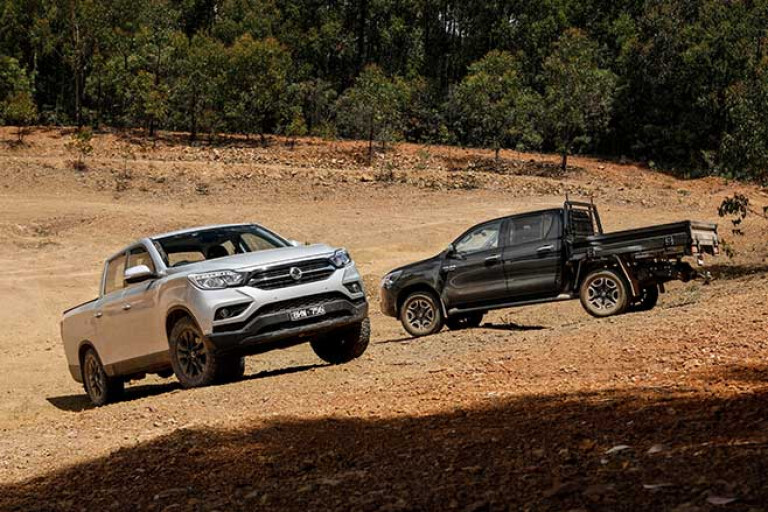
SsangYong can only dream about being anywhere near the pointy end of the new-car sales charts, but we’ve been mighty impressed with the comfort and performance of the Musso XLV Ultimate we had on long-term loan through the second half of the year. At more than $18,000 cheaper than the Hilux SR5, the Musso represents eye-opening value too.
With these factors in mind we took our long-termer out for a day in the woods with the updated SR5 auto, to see how they stack up and if the changes made by Toyota are enough to fix the complaints surrounding it.
TOYOTA HILUX SR5
THE updated Toyota Hilux lobbed in to showrooms in September and brought with it a new front-end design, fresh tail-lights at the back, interior upgrades, as well as much needed tweaks under the bonnet.
Toyota might not build any cars in Australia anymore but the company’s Australian designers and engineers played a big part in both the styling and mechanical changes for the 2021 updates, and it seems that it was work well done.
POWERTRAIN & PERFORMANCE
THE previous tune of Toyota’s 1GD engine had about as much life in it as 2020 a New Year’s party and felt totally outgunned by many of its competitors. Its claimed 130kW and 450Nm felt optimistic at best as it struggled to inspire with its performance.
The updated engine promises 150kW and 500Nm; matching the class-leading figures of any other four-cylinder diesel in the one-tonne ute segment. To get these numbers while improving fuel economy at the same time, the engineers equipped the engine with a new common-rail fuel system and a bigger, ball-bearing turbocharger, among other changes. A more rigid cylinder block is said to improve the NVH levels.
The changes have worked, giving Lazarus-like new life to the 1GD. There’s a noticeable improvement in acceleration right through the rev-range, but particularly in the mid-range where you use it most.
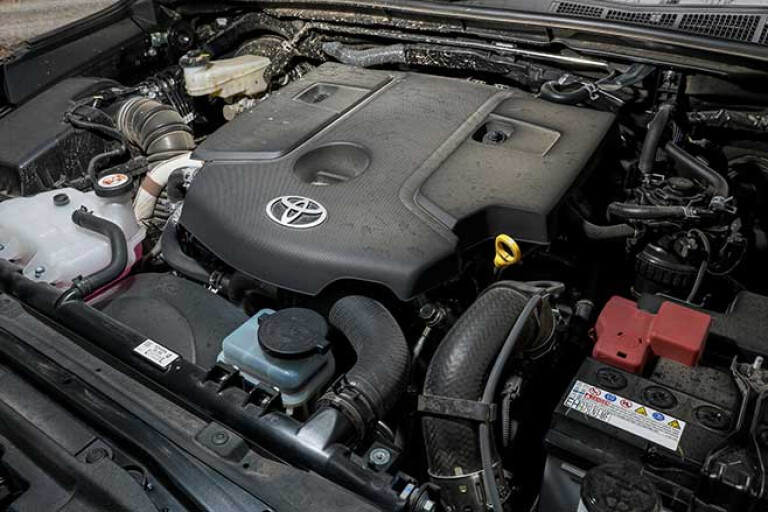
Toyota claims that maximum 500Nm of torque is now available from 1600 to 2800rpm when backed by the automatic transmission, as our test car was. Six-speed manual-equipped Hiluxes don’t get the same increase in torque and have to make do with 420Nm, which is on tap from 1400 to 3400rpm. There’s even a bit of turbo whistle evident when driving the Hilux now, which we don’t recall noticing in the past.
The six-speed automatic transmission has also been tweaked to match the engine’s performance, while the ‘Power’ mode button not only holds gears longer, it sharpens up the throttle response in much the same way as aftermarket throttle controllers do.
The changes to the engine and transmission have made the 2021 Hilux engaging to drive, something you could have never said about those with the earlier 1GD engine. It’s harder to discern any improvement in the engine’s NVH and it is still quite vocal when you put your foot down to appreciate the new-found performance.
ON-ROAD RIDE & HANDLING
THIS eighth generation of Hilux has been criticised since launch as having a harsh and choppy ride when unladen and, while this was warranted, it countered this with its ability with a heavy load on board – and isn’t this what a ute should be able to do?
Toyota has revised the spring, shock absorber and suspension bushes in 4x4 Hiluxes to improve the ride and handling; including the use of longer leaf springs to give a more supple ride without sacrificing load-carrying ability. The springs have also been moved outboard to improve handling stability.
Our test car was a cab-chassis model fitted with the factory steel tray and, driving it unladen, it was difficult to discern any improvement in ride and handling. This vehicle did feel softer and had better ride quality than the 2021 Rogue model we drove a couple of weeks before this SR5.
The Hilux handles as you would expect a workhorse ute to handle. The load-bearing rear end is stiff and a bit choppy, while the front end is soft and prone to wallow and pitch. The hydraulically assisted steering remains well-weighted with good feel, despite the changes made to the 2021 model, to make it lighter at low speeds and ease wheel effort when parking.
OFF-ROAD
ALL the things you might criticise a Hilux for on-road disappear when you leave the tar behind. The soft front suspension soaks up bumps and the cabin is well-isolated from road noise. Once you get off track and in to low range, the rear-end works wonderfully with better than average articulation from the leaf-sprung live axle. Water fording depth is quoted at 700mm and the engine air intake picks up from inside the fender.
.jpg)
The calibration of the electronic traction control has always been excellent in the eighth-gen Hilux, and that hasn’t changed with the updated model. It is so good you’ll rarely need to use the driver switchable rear differential lock.
CABIN & ACCOMMODATION
FORGETTING about any other updates, the new Hilux is better than the previous model because Toyota has gone back to having knobs/dials for the audio system’s volume and station selection, instead of annoying buttons. This has been a personal gripe of mine, and the functionality is so much better now with fast-acting and tactile dials back on the radio fascia. Winning!
That audio system has a new eight-inch display (up from seven) and Apple CarPlay and Android Auto are now standard inclusions. The gauge binnacle is also new, with a fresh look on the dials and a digital information display in between the speedo and tachometer.
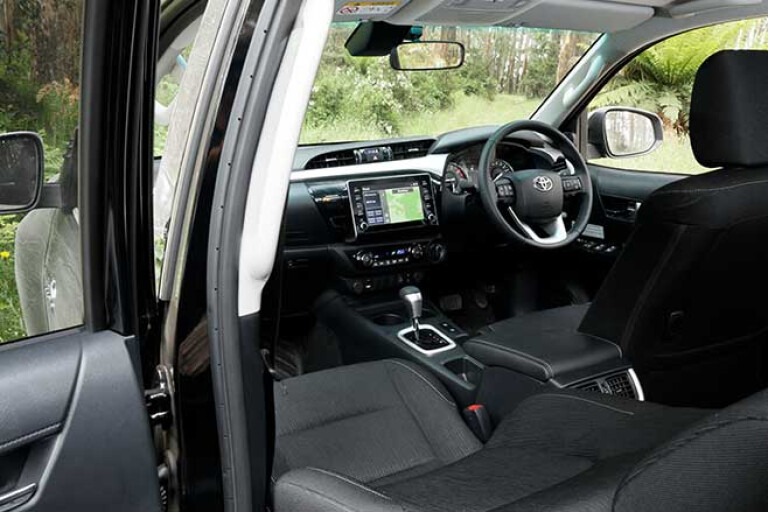
The front seats remain comfortable and accommodating and there’s good vision from the driver’s seat. On a side note, the JBL sound system that is fitted exclusively in the Hilux Rogue is a step above that of any in the lower-spec models and one of the better ones offered in 4x4 utes. That’s not saying much because across the segment they are all pretty average for sound quality.
4X4 HISTORY: 50 years of Hilux
The Hilux has all the common safety features including AEB, lane departure warnings, trailer sway control, pedestrian sensing pre-collision warning and lane keeping. Interestingly, as the Hilux retains hydraulic power steering, it can’t self-steer in the same way most other cars do to keep you in the lane. The Toyota steering assist is done through the brakes and, as such, is less intrusive than most of the similar systems that can pull the steering from your hands. The lane departure warning chime is also easily turned off via a button on the steering wheel.
The SR5 normally has a rear camera as well as parking sensors, but as this vehicle was fitted with a tray it misses out on these, and it’s surprising how often you now look to the AV screen for vision as well as the mirrors when reversing. Other ute manufacturers retain their reversing camera when fitted with a factory tray. A genuine Toyota accessories reversing camera for the tray is available as an optional extra.
PRACTICALITIES
RECENT problems aside, Toyota has been churning out 4x4 Hiluxes since 1978, so it knows a thing or two about building a working-class off-road ute. Things like the way it has retained hydraulic power steering for durability and the way the rear suspension works so well, comes from 40-plus years of evolution.
Even this high-spec SR5 double-cab spec has more than one-tonne payload, towing capacity is the 3500kg standard, there’s 700mm wading depth, a simple 4x4 system, excellent ETC and a host of Australian-designed genuine Toyota accessories. Consider the massive following from the aftermarket accessories industry and you can tailor a Hilux to do just about anything you need it to.
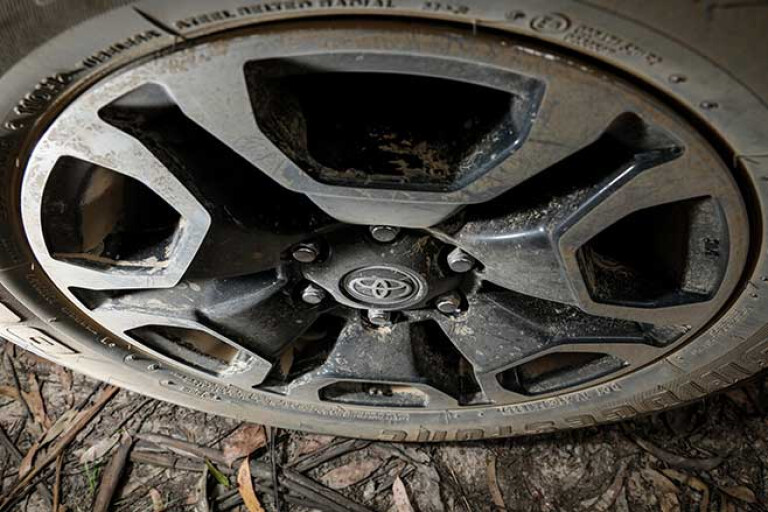
The SR5 rides on a 265/60-R18 tyre, which is fast becoming the standard size for this style of ute, so you shouldn’t have any troubles finding replacement or alternative tyres for it.
The genuine Toyota tray fitted to our test car adds a lot of practicality for load carrying, but the more popular ute tub holds plenty, even if its four tie-down points are mounted too high on the sidewalls.
With 18 models in the Hilux 4x4 range there should be a variant in there for everyone, so you can see why it remains so popular with buyers.
SSANYONG MUSSO XLV ULTIMATE
SSANGYONG mightn’t be the first name you think of when shopping for a 4x4 ute, but it has been selling 4x4s in Australia for more than 25 years and, like other South Korean auto brands, the products have come a long way in that time.
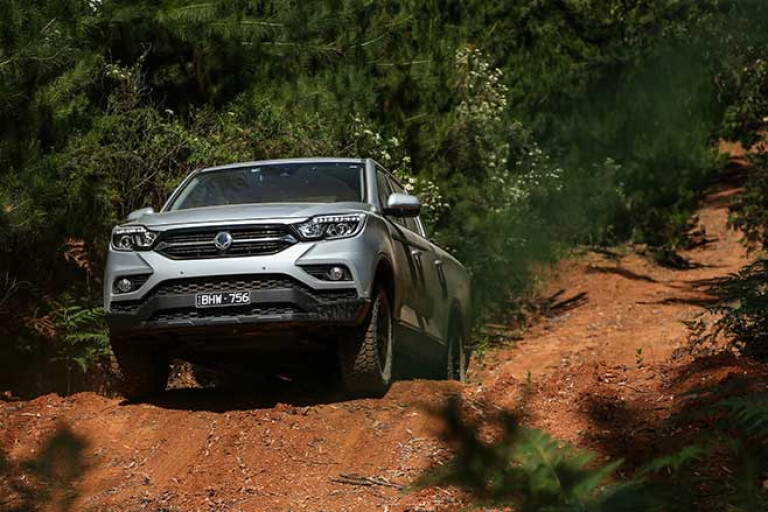
It’s been a turbulent time for the brand over the years with partnerships and owners including Mercedes-Benz, Daewoo, SAIC and more recently Mahindra throughout that time. Even as this is written, SsangYong is battling to pull itself out of receivership in its home country after Mahindra seeks to offload the brand.
Yet the latest Musso ute is a surprise package and well-worth any buyer’s consideration. It is available in two wheelbases and the longer XLV is what we have here in Ultimate, the middle of three available specification levels. The Musso XLV Ultimate starts at just $39,990, but there’s a lot more going for it than just being a value package.
POWERTRAIN & PERFORMANCE
MUSSO is Korean for Rhino, and the powerplant is a grunty, little 2.2L diesel engine that makes a modest 133kW and 420Nm. That’s a way off the class leaders with 500Nm but it gets along alright, even if you need to plan those overtaking moves very well.
What it lacks in performance it makes up for in refinement, and the Musso is arguably the quietest four-cylinder diesel ute in the segment; surprising some passengers who can’t believe it’s a diesel engine. It’s also pretty good on fuel use, bettering the Hilux on this test recording 11.85L/100km. It’s worth noting our Musso is fitted with aggressive LT all-terrain tyres that do nothing for fuel savings.

The engine is backed by a six-speed automatic transmission from Aisin, which is probably related to the one in the Toyota. It features ‘Power’ and ‘Eco’ modes, the former sharpens up the performance a bit, while full-manual control is via a toggle on the shift handle.
The 4x4 system is part-time with high and low range, and the rear differential has an effective auto-locking function.
ON-ROAD RIDE & HANDLING
SSANGYONG Australia teamed up with Ironman 4x4 to locally develop an approved suspension kit to improve off-road and towing performance, and this Musso is fitted with it. The kit is available from the dealer at the time of vehicle purchase or retrospectively and is covered by a factory seven-year warranty. Kudos to SsangYong for giving buyers this option.
Also credit for offering a choice of leaf or coil rear-suspension systems and equipping the Musso with four-wheel disc brakes, something you won’t find on many other new 4x4 utes. The XLV Ultimate has the all-coil configuration and, with the Ironman kit, it’s a well-sorted package.
The Musso rides firm and feels a bit jittery over small high-frequency bumps, but it’s not uncomfortable. More noticeable is how well-controlled the suspension is, something that only comes from quality aftermarket dampeners and very few OE setups will offer. The Musso steers and corners flat with that confidence-inspiring control.
OFF-ROAD
THAT rough-road jitteriness is amplified on gravel and particularly corrugated roads, prompting the driver to lower the tyre pressures to improve the ride for extended gravel and off-road driving. The superior control of the suspension comes to the fore again in these conditions and in low-speed off-road use.
The coil rear suspension doesn’t offer the axle articulation of the Toyota’s leaf-sprung rear nor is the electronic traction control as fast-reacting or effective. But when it hikes a tyre and breaks traction you quickly feel the rear diff lock kick in to maintain forward progress. Yes, this is slower reacting than a well-calibrated ETC system and you feel the momentum loss before the differential locks up, but, once it does, it is very effective.
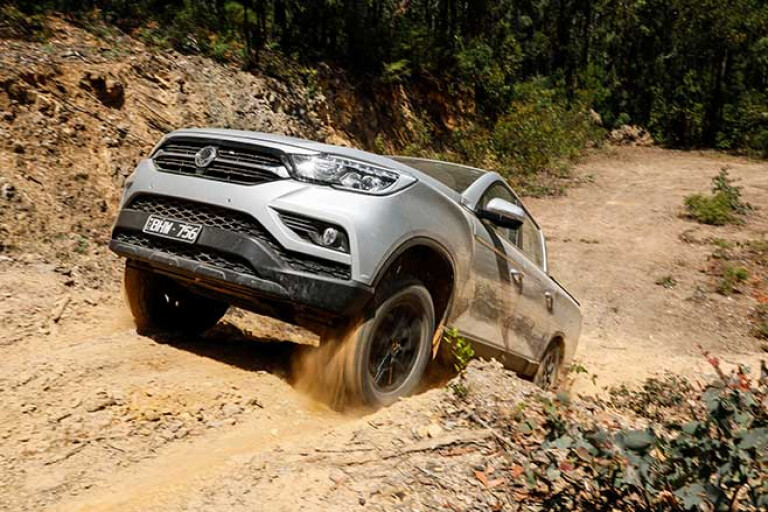
The off-road suspension kit raises the Musso some 40mm over stock, but it is still a low vehicle with plenty of overhang at the rear due to the XLV’s 300mm longer tray than the short wheelbase Musso. The XLV is 110mm longer in the wheelbase than a stock Musso, so the belly is also susceptible to scraping over erosion mounds. This car is fitted with dealer optional underbody protection, which again was developed by Ironman 4x4.
CABIN & ACCOMMODATION
The most appreciated feature of the Musso is its cabin, both for its size and features. Climb aboard after being in any other double-cab ute and you instantly feel the extra width of the cabin with plenty of shoulder room in both the front and back seats. Short of an American pickup, only the VW Amarok comes close to the feeling of space inside a Musso. The long dashboard accentuates the cabin and its large eight-inch AV screen includes Apple CarPlay and AA for all your mapping and entertainment needs.
There are three specification grades for the Musso XLV: ELX, Ultimate (as we have here) and the top-spec Ultimate+. The mid-spec Ultimate gets heated and cooled faux-leather seats for an instant feel of luxury, but as you dig deeper you find they are manually adjustable and the air-con is manual with no auto climate control. It’s now you remember this is a $39,990 drive-away vehicle.

The driver’s aids/safety package is comprehensive, including AEB with front collision warning, lane departure warnings, radar cruiser control, blind spot indicator and rear cross traffic alert. That last feature is one we particularly like and you can’t get on the Hilux.
Also worthy of note is the excellent tyre-pressure monitoring system (TPMS) displayed in the information menu in the dash binnacle. It displays individual pressures for each tyre, gives warnings for both high and low pressure, and randomly displays the TPMS to keep the driver aware of a vital function.
PRACTICALITIES
THE coil-sprung Musso XLV is limited to an 880kg payload, but the leaf-spring models are 1025kg, and both have 3500kg braked towing capacity. The XLV’s tub is one of the biggest in the business and swallows a heap of gear. There are four tie-down points inside plus a 12-volt outlet.
The Musso XLV Ultimate’s tyres are also the popular 265/60-R18 size.
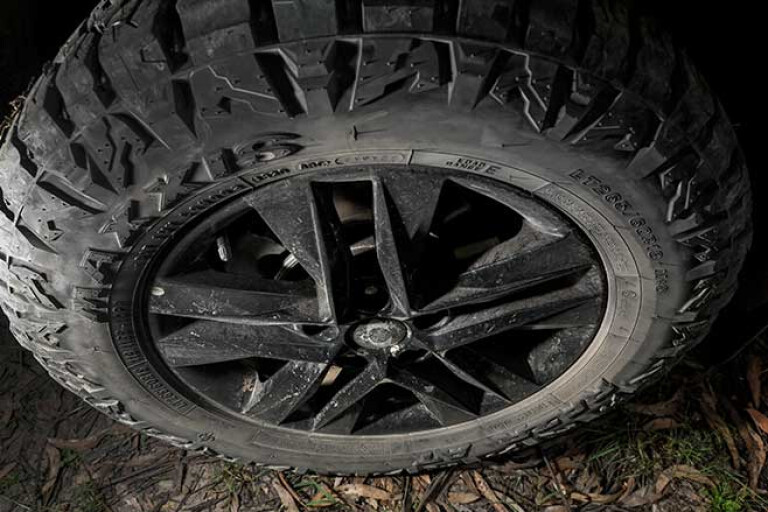
The engine air inlet is high on the forward edge of the radiator support panel so it's not ideal for water crossing and the 350mm fording depth requires care; while the rear-view camera and parking sensors help with negotiating the big ute on tight tracks.
As a relatively small seller, the Musso isn’t overly supported by aftermarket kit, but SsangYong has partnered with some of the biggest brands such as Ironman 4x4, Carryboy canopies and Rola roof racks to offer a comprehensive range of factory-backed gear.
SUMMARY
THIS might seem like an odd comparison where we have what is one of the most popular cars in the country with decades of evolution and sales behind it, lined up against a virtual minion in the 4x4 ute segment. However, they both compete in the same category and each of them has their plusses and negatives; yet the clincher is one of them is around $18K cheaper to drive out of the dealership.
The Musso XLV comes in swinging with its affordable pricing, seven-year factory warranty and roadside assistance, comprehensive safety kit, large cabin and cargo tub, well-sorted optional suspension package, and premium interior feel; but it is let down by its modest engine performance, limited off-road ability and a ride quality that could be better.

The Hilux, as always, has its well-earned reputation of dependability, quality and workhorse capability, and there’s nothing to say this has been compromised. Toyota has taken note of recent criticisms and addressed them with a massive improvement in engine performance, as well as an updated and improved interior fit-out. Toyota does claim to have addressed its DPF issues as well, however it’s too early to tell how successful that fix has been.
The question remains, is that 40-plus years of 4x4 Hilux development worth the considerable amount of extra money?
If you were looking for a 4x4 ute to equip for an off-road adventure around the country, we’d say it would be money well spent choosing the Toyota. However, for general family use around town and the occasional bush getaway, it is very hard to look past the SsangYong with its bigger cabin, extra equipment, longer warranty and more affordable purchase price.
TOYOTA HILUX SR5 SPECS
ENGINE: 2.8-litre 4-cyl turbo diesel
MAX POWER: 150kW at 3400rpm
MAX TORQUE: 500Nm from 1600 to 2800rpm
TRANSMISSION: 6-speed automatic
TRANSFER CASE: Part-time 4x4 w/ high/low range
STEERING: Hydraulic-assist rack and pinion
FRONT SUSPENSION: IFS w/ upper and lower control arms, coil springs
REAR SUSPENSION: Live axle, leaf springs, stabiliser bar
TYRES: 265/60-R18
KERB WEIGHT: 2093kg
PAYLOAD: 1105kg (cab-chassis)
TOWING CAPACITY: 3500kg
GVM: 3050kg
GCM: 5850kg
FUEL TANK CAPACITY: 80L
ADR FUEL USE: 7.9L/100km
TEST FUEL USE: 12.96L/100km
APPROACH ANGLE: 29°
RAMPOVER ANGLE: n/a
DEPARTURE ANGLE: 27°
WADING DEPTH: 700mm
GROUND CLEARANCE: 216mm
SSANYONG MUSSO XLV ULTIMATE SPECS
ENGINE: 2.2-litre 4-cyl turbo diesel
MAX POWER: 133kW at 4000rpm
MAX TORQUE: 420Nm at 1400-2800rpm
TRANSMISSION: 6-speed auto
CRAWL RATIO: 34.95:1
4X4 SYSTEM: Dual-range part-time
FRONT SUSPENSION: IFS w/ upper and lower control arms, coil springs
REAR SUSPENSION: Live axle, coil springs, stabiliser bar
TYRES: 265/60-R18
KERB WEIGHT: 2160kg
GVM: 2980kg
PAYLOAD: 880kg
TOWING CAPACITY: 3500kg
GCM: 6130kg
FUEL TANK CAPACITY: 75L
ADR FUEL CLAIM: 8.2L/100km
TEST FUEL USE: 11.85L/100km
APPROACH ANGLE: 21.5°
RAMPOVER ANGLE: 21.3°
DEPARTURE ANGLE: 27.1°
GROUND CLEARANCE: n/a
WADING DEPTH: 350mm



COMMENTS